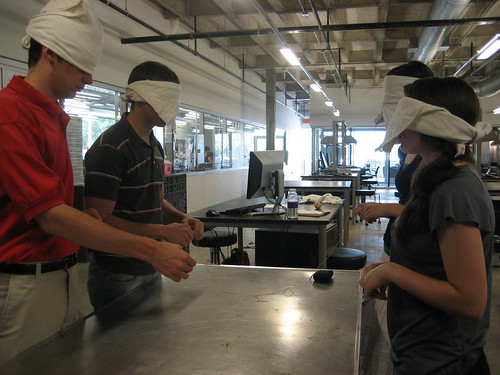After spending a restless night in our tent at the Chick-fil-A in Port Arthur, we took our 52 free meals and headed for home. Since we did not get back to the Rice campus until 8:00 AM, we decided to start work at ten o’clock to give us time to prepare for the intense day ahead. We arrived at the Design Kitchen feeling clean, renewed, and ready for anything.
Our fist task was to complete each Pugh Analysis for the four individual pieces that we started at the beginning of the week. This analysis consisted of numerically evaluating nearly 150 ideas, using evaluation criteria we created specifically to illuminate the strengths and weaknesses of each storage design. Once it was complete, we used the numerical valuation of each idea to narrow the available options down to a top ten for each piece.
After we finished the Pugh Analysis, we had to make haste and delegate tasks in order to meet the needs of the demanding day. Caleb revised and edited a powerpoint presentation for a meeting with Julie Bakke and Wynne Phelan of the Museum of Fine Arts, Houston. Nicole and he had created the bulk of the presentation earlier in the week for the Center for Civic Engagement meeting, but the new version was tailored to give deeper insight into our process.
Rhodes had a very challenging task of finishing the financial projections portion of the business plan for the Innovation Norway Course. This document includes the assumptions we made that provided the basis for our financial projections. Some of categories include revenue, expenses, and earnings before interest and tax. Our financial projection section also included graphs of units sold per year and trends of the categories mentioned above.
While Rhodes and Caleb attended the weekly Innovation Norway class, Kristi and Nicole stayed at the Design Kitchen to push forward in the solution phase. Earlier, each person in the team picked two ideas they liked best, regardless of the Pugh Analysis, and start a new idea pot. Each person then added the two best designs from each top ten list to the pot. Nicole and Kristi took the new idea pot and explored the possibilities of each idea. They combined the best features of different ideas and created concepts with full functionality. Kristi masterfully drew pictures of each concept, seven in all.
With the powerpoint ready and the seven concepts drawn, it was time to meet with Chief Registrar, Julie Bakke and Director of Conservation, Wynne Phelan of MFAH. Rhodes and Caleb gave the presentation, and Nicole and Kristi discussed each design. We were very pleased at how well the designs were received by Julie and Wynne! We left at six o’clock with high hopes from their encouragement and enthusiasm of our ideas.










